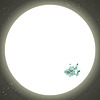HOME | DD
 Babylon218 — Flag of the Federated States of Earth
Babylon218 — Flag of the Federated States of Earth

#flagdesign #heraldry #original #originaldesign #sciencefiction #scifi #worldgovernment
Published: 2021-02-10 18:45:52 +0000 UTC; Views: 3719; Favourites: 37; Downloads: 11
Redirect to original
Description
The Flag of the Federated States of Earth (FSE) consists of three diagonal stripes of white, red, and azure in the lower-sinister portion and a dark blue field in the upper-dexter portion. Charged atop this is a white-borded blue orb representing Earth superimposed on an off-white orb representing its moon, Luna (and by extension the Luna colonies). The dark blue represents space, with the three coloured striped being the three most-common national colours of Earth's nations. The FSE Flag also serves as the basis for the flags of Earth's Federal Republics (devolved colonial administrations) and the banners of the Defence Forces. Members of the defence forces, under the Nationalities Act (2206), may choose to display the Federal flag or flag of their Republic in place of their usual national flag on their right shoulder if preferred.
____
The Federated States of Earth can trace its history to the Post-Bellum period following the Third World War of 2071-4. With the global economy having virtually-completely collapsed and much of the planet on the brink of over a hundred resource wars over what was left, the North American nations (the United States of America, Canada, and the United Mexican States) began a process of confederation, with the intention of forming a single market to combine the strengths of all three reeling economies. Across the Atlantic, there seemed a very real threat that the Russian Federation might, in a scramble for resources, invade much of Europe. As a result, the North American Summit quickly expanded to include the entirety of the North Atlantic Treaty Organisation (NATO) as, for all intents and purposes, NATO’s economic counterpart – the North Atlantic Commerce Union (NACU).
Over the next century, NACU’s remit merged with NATO and expanded to include most of the former European Union, several North African states, most of South and Central America, Japan, Korea, Australia and New Zealand, etc, ultimately growing into the Federated States of Earth in 2163. By 2190, only China and the Russian-led Confederation of Independent States (CIS, consisting of Russia; Serbia; Armenia; Cuba; Kazakhstan; Uzbekistan; Turkmenistan; Tajikistan; Kyrgyzstan; Mongolia; and Belarus) remained outside the Federated States. This changed in 2191 when, after over two decades of negotiations following the so-called Fourth Cold War (2112-2165), the states of the CIS and China were jointly admitted to the Federation, completing a century-long process of planetary unification.
Under the Federal Charter of 2163, the Federated States of Earth is a Parliamentary Federal Democracy, with a bicameral Parliament consisting of an Upper House (the Federal Council) and a Lower House (the Federal Assembly). The Federal Council is made up of two representatives from each state, with the second seat going to the designated Opposition of that state. As of 2218, the Federal Council has 396 members. The Federal Assembly, by contrast, is popularly-elected every five years, with seats being allocated to political parties by Proportional Representation. Officially, there are 1000 seats in the Federal Assembly; however, for logistical purposes it is conventional for members to select one other member to vote on their behalf – this practice is known as ‘delegation’ – bringing the typical number of members in the chamber at any one time down to a more manageable 600.
Among the responsibilities of the Federal Council are vetting the candidates for Ministerial posts, authorising defence commitment bills (which determine what percentage of each state’s total military budget must be contributed to the Federal Defence budget), and matters regarding the sovereignty of member states. Any resolution originating in the Council must receive at least 2/3rds of the vote of all members present in order to pass into force.
The Federal Assembly, meanwhile, is responsible for all other forms of legislation, including the Federal Budget. In practice, the Federal Council acts as a veto for any 67 member states which oppose any Assembly legislation, though this power has only been exercised four times in the Federated States’ history (two of those times during the Tau Ceti Crisis, 2212-2216).
The President of the Federated States is elected by the Federal Council by majority from a list of the five most popular candidates by popular vote. If no one candidate can secure a majority, then the candidate with the least support is discounted and another Council vote held until any remaining candidate achieves a majority. Controversially, only the members present in Council at the time are counted for the purposes of determining a majority. This is intended to discourage absenteeism, though some member states claim it unfairly prejudices less-stable members.
The President is responsible for appointing the Federal Government, beginning with the First Minister (who serves as the Head of Government) and Defence Minister. Beyond this, the President is largely uninvolved with day-to-day governance, save for serving as Commander-in-Chief of the Federal Defence Forces and holding certain Executive Powers, such as the power to dismiss the First Minister or any member of the Government (subject to request by the Attorneys-General or the Supreme Court, or confirmation by a majority of the Federal Council), declare a State of Emergency (which can be countermanded by either the Federal Council or the Federal Assembly), and dissolve the Legislature, automatically triggering new elections (including to the Presidency).


















